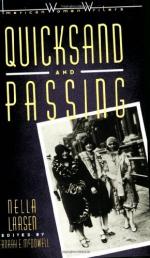|
This section contains 627 words (approx. 2 pages at 400 words per page) |

|
Quicksand and Passing Summary & Study Guide Description
Quicksand and Passing Summary & Study Guide includes comprehensive information and analysis to help you understand the book. This study guide contains the following sections:
This detailed literature summary also contains Topics for Discussion and a Free Quiz on Quicksand and Passing by Nella Larsen.
In Quicksand, Helga Crane, a young Mulatto teacher in a Negro school in Naxos, Georgia, is born of a white mother and black father. Deeply lonely as a child, she has not been able to identify herself as either white or black. Quicksand opens with Helga's decision to leave Naxos and move to Chicago because she is tired of the racial politics of the school. She announces her resignation to the school's principal, Dr. Anderson, to whom she is very attracted, breaks her engagement to a teacher named James Vayle, and leaves Naxos, relieved.
In Chicago, her formerly-reliable white Uncle Peter has a new wife, who rejects Helga due to her mixed race. Helga, alone and broke, finds work with an educated, wealthy woman named Mrs. Hayes-Rore, who asks Helga to edit her speeches on racial equality. Helga travels with her to New York and decides to stay on, living with a new acquaintance, Anne Grey, a wealthy Harlem socialite. Helga revels in her new life in New York, working for an Negro insurance company and attending social functions with Anne. But, eventually, Helga becomes tired of Anne and of the race-conscious culture in Harlem and leaves for Denmark to live with her Aunt Katrina and Uncle Poul. There, she is treated like a wealthy, beautiful peacock. But after she rejects an unfortunate marriage proposal, Helga tires of her privileged, formal Danish life, and misses Negroes. Anne Grey marries Dr. Anderson, and Helga returns to Harlem for their wedding. After having a brief hope that Dr. Anderson loves her, he rejects Helga. Now desperate, Helga finds God and meets the Rev. Pleasant Green, whom she happily marries the next day. They move to Alabama and live in poverty; by her fourth child, Helga renounces God during a serious illness related to childbirth. She realizes how much she hates her husband and her life and makes plans to leave, but the story ends with the birth of her fifth child, and we are left to assume that Helga is forever doomed to poverty and misery.
Passing is the story of a Mulatto woman whose skin is so fair that she made the decision to "pass" as a white woman. Beautiful, fair-skinned Clare Kendry has married a bigoted white man and has lived an adult life of wealth and privilege, but she secretly longs to be back among Negroes. When she meets a childhood friend, Irene Redfield, Clare begins working her way back into the company of blacks, unbeknown to her husband. Although Irene questions Clare's motives and does not trust her, she is strangely drawn to Clare, who is very persuasive. Clare joins Irene's social circle and eventually has an affair with Irene's husband. When Clare's own husband learns that Clare is really a black woman, he storms a party and confronts her. In the hubbub, Clare mysteriously falls from the16th story window to her death. There is the possibility that Irene has pushed her, although it is not clear whether Irene is simply distraught and thinks she did it, or whether she deliberately pushed her. The story ends with the reader questioning which of the women was truly mentally disturbed, and whether it was worth it for Clare to take the risks to get what she wanted.
Both stories deal with the practice of "passing," which was a common practice in the 1920s, when so many black women were products of white men's brutality toward black women, and when Negroes began to own and strengthen their culture in places like Harlem. Larsen's adult characters tend to be well-to-do and educated for the most part, but all are starkly aware of the plight of blacks in America, and racism is a strong theme.
Read more from the Study Guide
|
This section contains 627 words (approx. 2 pages at 400 words per page) |

|



